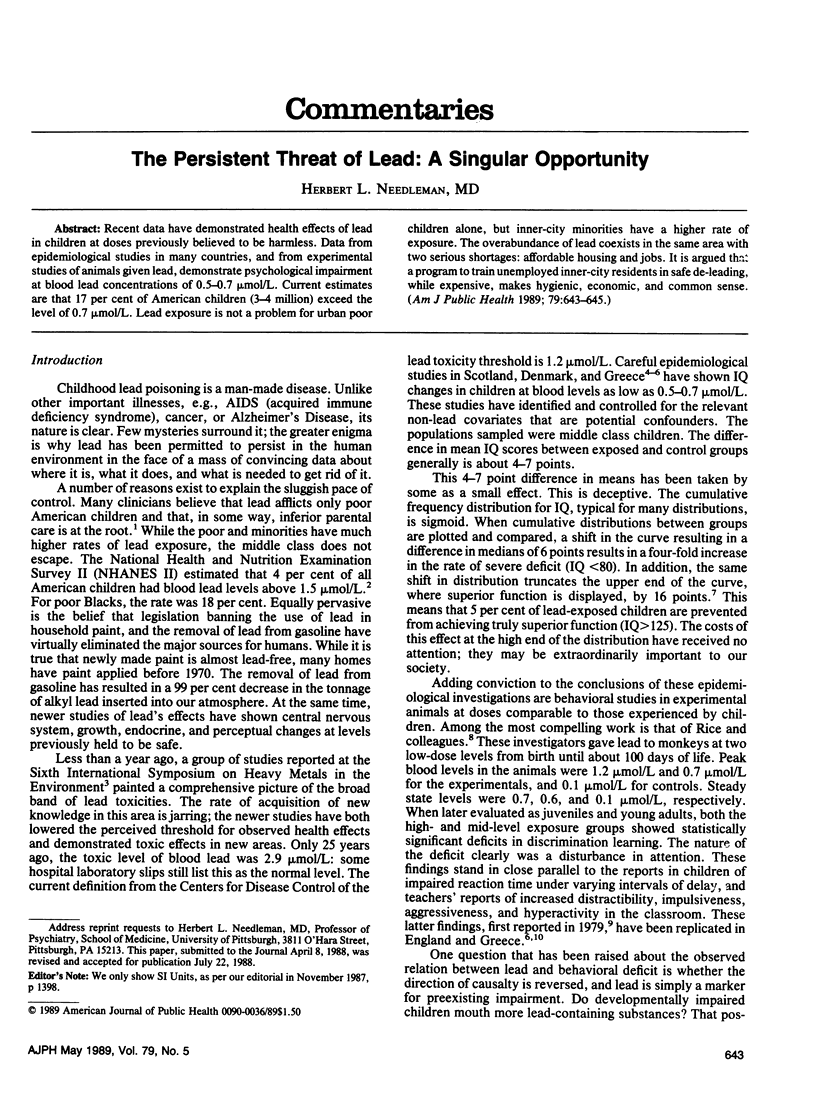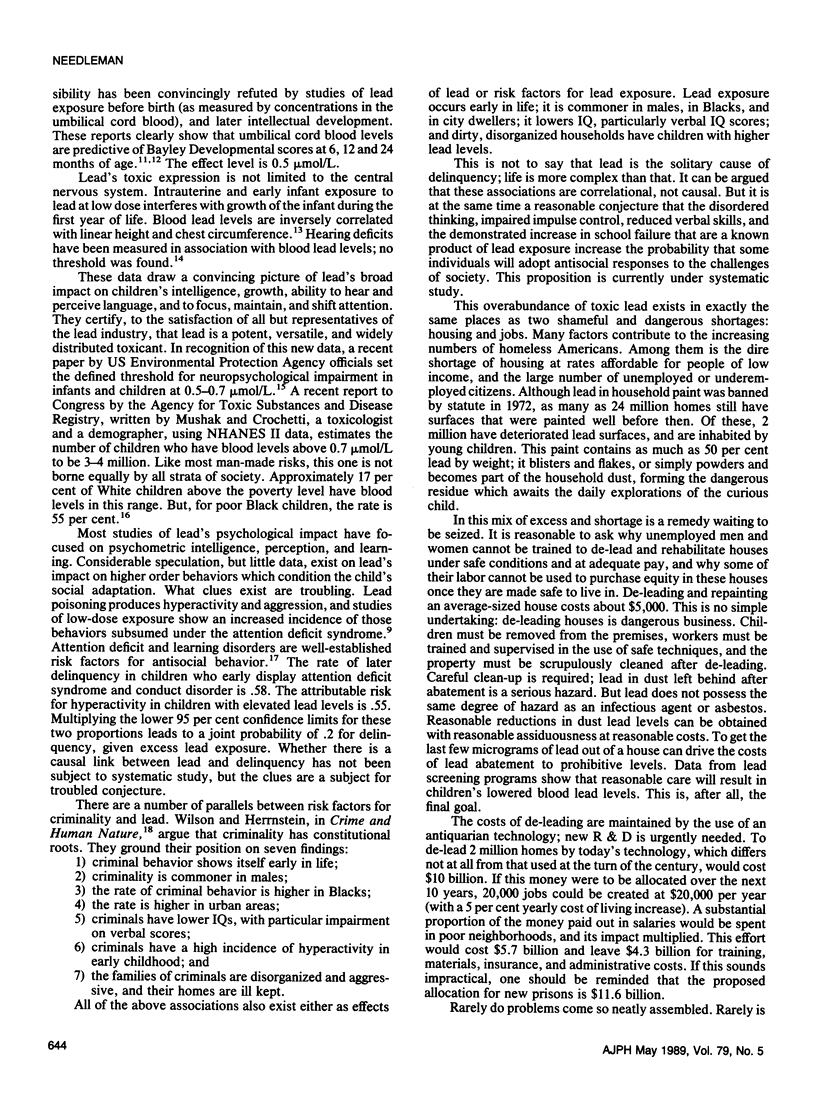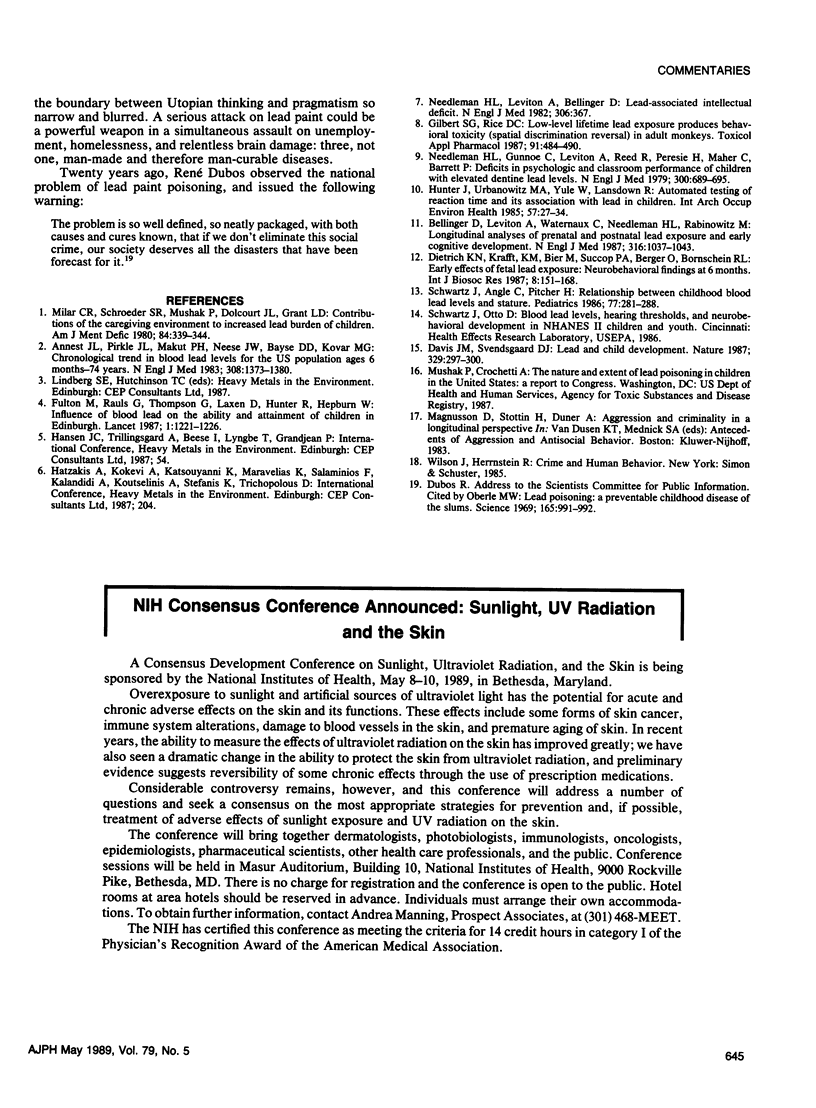Abstract
Recent data have demonstrated health effects of lead in children at doses previously believed to be harmless. Data from epidemiological studies in many countries, and from experimental studies of animals given lead, demonstrate psychological impairment at blood lead concentrations of 0.5-0.7 mumol/L. Current estimates are that 17 per cent of American children (3-4 million) exceed the level of 0.7 mumol/L. Lead exposure is not a problem for urban poor children alone, but inner-city minorities have a higher rate of exposure. The overabundance of lead coexists in the same area with two serious shortages: affordable housing and jobs. It is argued that a program to train unemployed inner-city residents in safe de-leading, while expensive, makes hygienic, economic, and common sense.
Full text
PDF


Selected References
These references are in PubMed. This may not be the complete list of references from this article.
- Annest J. L., Pirkle J. L., Makuc D., Neese J. W., Bayse D. D., Kovar M. G. Chronological trend in blood lead levels between 1976 and 1980. N Engl J Med. 1983 Jun 9;308(23):1373–1377. doi: 10.1056/NEJM198306093082301. [DOI] [PubMed] [Google Scholar]
- Bellinger D., Leviton A., Waternaux C., Needleman H., Rabinowitz M. Longitudinal analyses of prenatal and postnatal lead exposure and early cognitive development. N Engl J Med. 1987 Apr 23;316(17):1037–1043. doi: 10.1056/NEJM198704233161701. [DOI] [PubMed] [Google Scholar]
- Davis J. M., Svendsgaard D. J. Lead and child development. Nature. 1987 Sep 24;329(6137):297–300. doi: 10.1038/329297a0. [DOI] [PubMed] [Google Scholar]
- Fulton M., Raab G., Thomson G., Laxen D., Hunter R., Hepburn W. Influence of blood lead on the ability and attainment of children in Edinburgh. Lancet. 1987 May 30;1(8544):1221–1226. doi: 10.1016/s0140-6736(87)92683-3. [DOI] [PubMed] [Google Scholar]
- Gilbert S. G., Rice D. C. Low-level lifetime lead exposure produces behavioral toxicity (spatial discrimination reversal) in adult monkeys. Toxicol Appl Pharmacol. 1987 Dec;91(3):484–490. doi: 10.1016/0041-008x(87)90070-6. [DOI] [PubMed] [Google Scholar]
- Hunter J., Urbanowicz M. A., Yule W., Lansdown R. Automated testing of reaction time and its association with lead in children. Int Arch Occup Environ Health. 1985;57(1):27–34. doi: 10.1007/BF00383543. [DOI] [PubMed] [Google Scholar]
- Milar C. R., Schroeder S. R., Mushak P., Dolcourt J. L., Grant L. D. Contributions of the caregiving environment to increased lead burden of children. Am J Ment Defic. 1980 Jan;84(4):339–344. [PubMed] [Google Scholar]
- Needleman H. L., Gunnoe C., Leviton A., Reed R., Peresie H., Maher C., Barrett P. Deficits in psychologic and classroom performance of children with elevated dentine lead levels. N Engl J Med. 1979 Mar 29;300(13):689–695. doi: 10.1056/NEJM197903293001301. [DOI] [PubMed] [Google Scholar]
- Needleman H. L., Leviton A., Bellinger D. Lead-associated intellectual deficit. N Engl J Med. 1982 Feb 11;306(6):367–367. doi: 10.1056/NEJM198202113060618. [DOI] [PubMed] [Google Scholar]
- Oberle M. W. Lead poisoning: a preventable childhood disease of the slums. Science. 1969 Sep 5;165(3897):991–992. doi: 10.1126/science.165.3897.991. [DOI] [PubMed] [Google Scholar]
- Schwartz J., Angle C., Pitcher H. Relationship between childhood blood lead levels and stature. Pediatrics. 1986 Mar;77(3):281–288. [PubMed] [Google Scholar]


